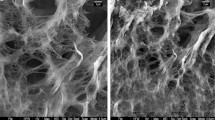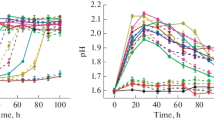Summary
The selective accumulation of heavy metal ions byChlorella regularis was investigated. The amounts of heavy metal ions taken up byChlorella cells decreases in the following order:
for livingChlorella cells and:
for heat-killedChlorella cells.
To determine which components ofChlorella cells are involved in heavy metal ion binding, the uptake of heavy metal ions by chemically treatedChlorella cells and byChlorella cell walls was studied. The cell components which remain after alkali extraction play a fairly important role in heavy metal ion binding while those which remain after extraction with hot water or chloroform-methanol and the cell fraction obtained with a chloroform-methanol/concentrated alkali treatment are involved, but to a lesser extent, with heavy metal ion binding. It is suggested that uptake of heavy metal ions byChlorella cells is dependent on adsorption by proteins and that the amount of adsorption varies for each heavy metal ion. Uranyl ion was most readily taken up by the cells and the uptake of cadmium ion by the cells was low because of the presence of and competition from uranyl and copper ions.
To investigate which component of heat-killedChlorella cells is involved in heavy metal ion binding, the uptake of heavy metal ions by heat-killedChlorella cells treated with acid was studied. The acid extracted components were mainly responsible for copper and cadmium ion binding but only slightly responsible for the binding of uranyl ion.
Similar content being viewed by others
References
Failla ML, Benedict CD, Weinberg ED (1976) Accumulation and storage of Zn2+ byCandida utilis. J Gen Microbiol 94:23–26
Horikoshi T, Nakajima A, Sakaguchi T (1977) Studies on the accumulation of heavy metal elements in biological systems III. Concentration of copper ion byChlorella cells pretreated with metabolic inhibitors or heating. J Agric Biol Chem Jpn 51:583–589
Horikoshi T, Nakajima A, Sakaguchi T (1979) Studies on the accumulation of heavy metal elements in biological systems IV. Uptake of uranium byChlorella regularis. Agric Biol Chem 43:617–623
Naiki N, Yamagata S (1976) Isolation and some properties of copper-binding protein found in a copper-resistant strain of yeast. Plant Cell Physiol 17:1281–1295
Nakajima A, Horikoshi T, Sakaguchi T (1977) Studies on the accumulation of heavy metal elements in biological systems II. Chemical state of copper accumulated inChlorella regularis. J Agric Biol Chem Jpn 51:507–511
Nakajima A, Horikoshi T, Sakaguchi T (1979a) Studies on the accumulation of heavy metal elements in biological systems V. Ion effects on the uptake of uranium byChlorella regularis. Agric Biol Chem 43:625–629
Nakajima A, Horikoshi T, Sakaguchi T (1979b) Studies on the accumulation of heavy metal elements in biological systems XII. Uptake of manganese ion byChlorella regularis. Agric Biol Chem 43:1461–1466
Nakamura Y, Katayama S, Okada Y, Suzuki F, Nagata Y (1981) The isolation of cadmium and zinc binding protein fromTetrahymena pyriformis. Agric Biol Chem 45: in press
Northcote DH, Goulding KJ, Horne RW (1958) The chemical composition and structure of the cell wall ofChlorella pyrenoidosa. Biochem J 70:391–397
Sakaguchi T, Horikoshi T, Nakajima A (1977) Studies on the accumulation of heavy metal elements in biological systems I. Uptake of copper ion byChlorella regularis. J Agric Biol Chem Jpn 51:497–505
Sakaguchi T, Tsuji T, Nakajima A, Horikoshi T (1979) Studies on the accumulation of heavy metal elements in biological systems XIV. Accumulation of cadmium by green microalgae. Eur J Appl Microbiol Biotechnol 8:207–215
Author information
Authors and Affiliations
Rights and permissions
About this article
Cite this article
Nakajima, A., Horikoshi, T. & Sakaguchi, T. Studies on the accumulation of heavy metal elements in biological systems. European J. Appl. Microbiol. Biotechnol. 12, 76–83 (1981). https://doi.org/10.1007/BF01970038
Received:
Issue Date:
DOI: https://doi.org/10.1007/BF01970038




